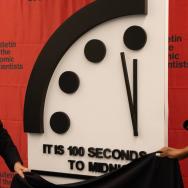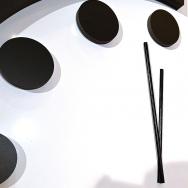The Doomsday Clock is a metaphor that represents how close humanity is to self-destruction, due to nuclear weapons and climate change.
The clock hands are set by the Bulletin of the Atomic Scientists, a group formed by Manhattan Project scientists at the University of Chicago who helped build the atomic bomb but protested using it against people.
The time of the clock is currently 89 seconds to midnight.
What are the origins of the Doomsday Clock?
The Doomsday Clock is a symbol that represents how close we are to destroying the world with dangerous technologies of our own making. It warns how many metaphorical “minutes to midnight” humanity has left. Set every year by the Bulletin of the Atomic Scientists, it is intended to warn the public and inspire action.
When it was created in 1947, the placement of the Doomsday Clock was based on the threat posed by nuclear weapons, which Bulletin scientists considered to be the greatest danger to humanity. In 2007, the Bulletin began including catastrophic disruptions from climate change in its hand-setting deliberations.
The furthest the clock has been set was 17 minutes to midnight, in 1991, after the collapse of the Soviet Union and the signing of the Strategic Arms Reduction Treaty. Until recently, the closest it had ever been set was at two minutes to midnight—first in 1953, when the U.S. and Soviet Union both tested thermonuclear weapons, and then in 2018, citing “a breakdown in the international order” of nuclear actors, as well as the continuing lack of action on climate change.
Then, in 2025, the clock moved the closest it has ever been: 89 seconds to midnight.
How was the Bulletin of Atomic Scientists founded?
Most of the people who were part of the Manhattan Project, the secret government mission which created the first atomic bomb, did not know what they were building. But the scientists did, and some of them had misgivings from the start.
Leo Szilard and Albert Einstein were the two physicists who wrote to President Franklin Roosevelt in 1939, warning him of the potential of an atomic bomb—and their suspicions that Germany might be able to build one. Six years later, in June 1945, Szilard, along with Nobel laureate James Franck and other fellow Manhattan Project scientists, signed a cautionary document known as the Franck Report, which they sent to the U.S. secretary of war. They argued that the United States should announce a public demonstration of the weapon in an uninhabited area, and then use the threat to press Japan to surrender. When that document failed to progress, they circulated a second petition against the use of the weapon, signed by nearly 70 fellow Manhattan Project employees.
Neither attempt succeeded. In August 1945, the U.S. dropped atomic bombs on the cities of Hiroshima and Nagasaki.
When Szilard learned the bomb had been dropped on Hiroshima, he called it “one of the greatest blunders of history” (in a note on stationery from the University of Chicago Quadrangle Club to Gertrud Weiss, the professor of medicine whom he later married).
Szilard and many other Manhattan Project scientists immediately met to discuss how to inform the public about science and its implications for humanity. By September, they had formed the Bulletin of the Atomic Scientists of Chicago—later shortened to the Bulletin of the Atomic Scientists as its membership grew. They shared a mission: “to equip the public, policymakers and scientists with the information needed to reduce man-made threats to our existence.”
“For the first time in modern history, scientists were saying that it was necessary to make judgments about what to do with their inventions,” according to John A. Simpson, a young UChicago scientist who had worked on the Manhattan Project and served as the first chairman of the Bulletin.
For 75 years, the Bulletin has continued as an independent, nonprofit organization, publishing a bimonthly magazine. According to its website, its mission is to “gather a diverse array of the most informed and influential voices tracking man-made threats” in order to inform the public and the world at large.
How was the Doomsday Clock created?
The first few Bulletins were mimeographed collections of articles. But as the publication expanded, its editors decided to try to appeal to a wider audience with a designed cover. Bulletin member Martyl Langsdorf, an artist who mostly painted abstract landscapes, agreed to produce an illustration.
In response to the urgency she felt from the meetings, she designed a minimalist, but memorable clock—its hands set at seven minutes to midnight, in part because it “looked good to [her] eye.” Ever since, the Bulletin has used the clock to depict the existential threats facing humanity. A full timeline of the clock’s hand placements is available at the Bulletin’s website.
Where is the Doomsday Clock located?
The Doomsday Clock is located at the Bulletin offices at 1307 E. 60th St., in in the lobby of the Keller Center, home to the University of Chicago Harris School of Public Policy.
How is the Doomsday Clock set?
Until his death in 1973, Bulletin editor Eugene Rabinowitch decided whether the clock hand should be moved. As a leader in the international disarmament movement, he actively talked with policy experts and scientists around the world; he used these discussions to set the clock and explained his thinking in the Bulletin’s pages.
Today, the Bulletin’s Science and Security Board sets the clock. This group of 18 experts, with diverse backgrounds ranging from policy and diplomacy to military history and nuclear science, meets twice a year to discuss events, policies and trends. They consult widely with their colleagues across a range of disciplines and also seek the views of the Bulletin’s Board of Sponsors, which includes multiple Nobel laureates. Each year, the clock’s position is announced in late January.
The Bulletin currently recognizes three major threats to civilization: climate change, nuclear proliferation and “disruptive technologies,” including bio- and cybersecurity. “Each of these threats has the potential to destroy civilization and render the Earth largely uninhabitable by human beings,” it says. Its public dashboard tracks these threats constantly.
What happens when the Doomsday Clock hits midnight?
When it was originally launched, the clock’s countdown referred to an exchange of nuclear weapons, which would have large-scale consequences for humanity and the planet.
Today the threat from nuclear weapons remains, but another equally large threat is climate change. “It’s much harder to have a kind of before and after midnight clear sense of what that means [for climate],” former director Rachel Bronson told the University of Chicago’s Big Brains podcast. “That being said, this metaphor is important because for the climate, there are tipping points that you can’t come back from. And you won’t feel those effects until years out, but it’ll be very difficult if even possible to recover from.”
However, Bulletin members have constantly emphasized that the clock is not intended to make people fearful, but rather to spur them to action. Board member Prof. Robert Rosner calls the clock “the canary in the coal mine,” which prompts miners to take quick action to save their lives.
“The number of ways in which we walk blithely into Armageddon is very high. But that’s something all of us can help address,” said Daniel Holz, UChicago professor of astronomy and astrophysics and chair of the Science and Security Board. “If we act now, we might avoid some of the worst, civilization-threatening outcomes. Agitate for change! It’s not too late.”
“Past experience has taught us, even during the most dismal periods of the Cold War, we can as a people come together to address our challenges,” said Rosner, former chair of the Bulletin’s science and security board and the William E. Wrather Distinguished Service Professor in Astronomy & Astrophysics and Physics at the University of Chicago. “It is now high time to do so again.”
Last reviewed January 2025.





